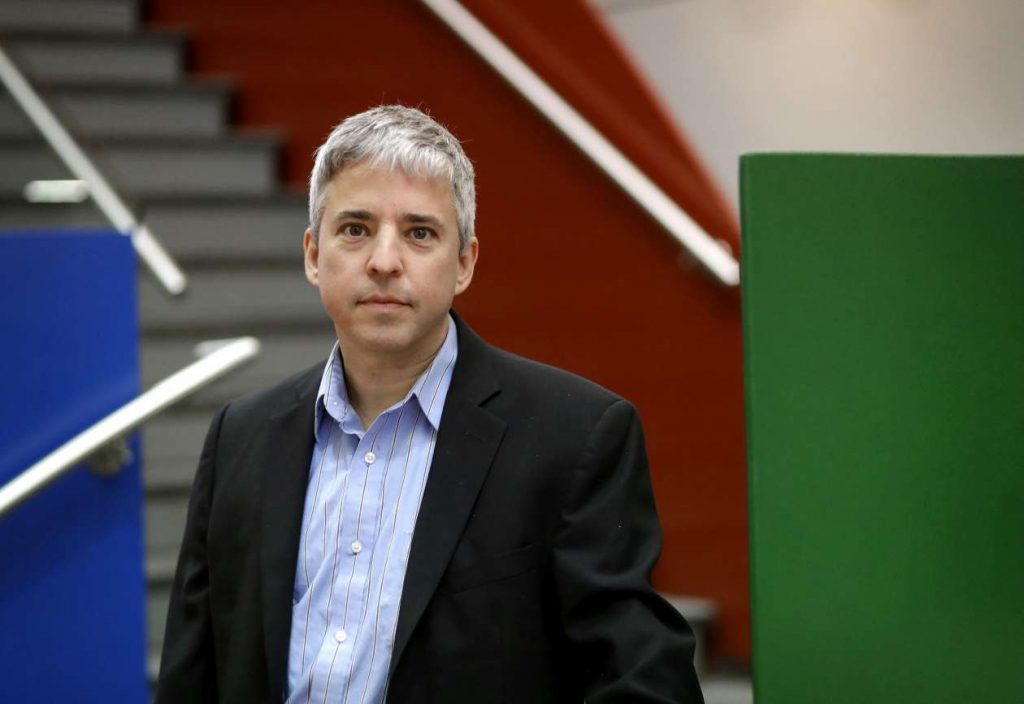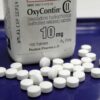This story was co-published with The Associated Press.
Introduction
Editor’s note: This is the latest installment of an ongoing series. The first parts explored the state political efforts surrounding opioids and how a loose coalition of drugmakers and industry-backed nonprofits shaped the federal response to the opioid crisis.
Pilloried for their role in the epidemic of prescription painkiller abuse, drugmakers are aggressively pushing their remedy to the problem: a new generation of harder-to-manipulate opioids that have racked up billions in sales, even though there’s little proof they reduce rates of overdoses or deaths.
More than prescriptions are at stake. Critics worry the drugmakers’ nationwide lobbying campaign is distracting from more productive solutions and delaying crucial efforts to steer physicians away from prescription opioids — addictive pain medications involved in the deaths of more than 165,000 Americans since 2000.
“If we’ve learned one lesson from the last 20 years on opioids it’s that these products have very, very high inherent risks,” said Dr. Caleb Alexander, co-director of Johns Hopkins University’s Center for Drug Safety and Effectiveness. “My concern is that they’ll contribute to a perception that there is a safe opioid, and there’s no such thing as a fully safe opioid.”
The latest drugs — known as abuse-deterrent formulations, or ADFs — are generally harder to crush or dissolve, which the drugmakers tout as making them difficult to snort or inject. But they still are vulnerable to manipulation and potentially addictive when simply swallowed. National data from an industry-sponsored tracking system also show drug abusers quickly drop the reformulated drugs in favor of older painkillers or heroin.

In the last two years, pharmaceutical companies have made a concerted under-the-radar push for bills benefiting the anti-abuse opioids in statehouses and in Congress, where proposed legislation would require the Food and Drug Administration to replace older opioids with the new drugs.
The lobbying push features industry-funded advocacy groups and physicians, along with grieving family members, who rarely disclosed the drugmakers’ ties during their testimony in support of the drugs.
Besides the tamper-resistant pills, ADF opioids are being rolled out in other forms, including injectable drugs and pills that irritate users when they’re snorted or contain substances that counteract highs.
Making painkillers harder to abuse is a common-sense step. But it’s also a multibillion-dollar sales opportunity, offering drugmakers the potential to wipe out lower-cost generic competitors and lock in sales of their higher-priced versions, which cost many times more than conventional pills. The big companies hold multiple patents on the reformulated drugs, shielding them from competition for years — in some cases decades.
Though abuse-deterrent painkillers represented less than 5 percent of all opioids prescribed last year, they generated more than $2.4 billion in sales, or roughly a quarter of the nearly $10 billion U.S. market for the drugs, according to QuintilesIMS. The field is dominated by Purdue Pharma’s OxyContin, patent-protected until 2030.
“We at Purdue make certain that prescribers and other stakeholders understand that opioids with abuse-deterrent properties won’t stop all prescription drug abuse, but they are an important part of the comprehensive approach needed to address this public health issue,” Purdue spokesman Robert Josephson said in a statement.
Like a spokeswoman for Pfizer Inc., Josephson also noted that some public health officials, including the Food and Drug Administration, have endorsed using ADFs.
“We need every tool that we can have in our toolbox,” said Kentucky state Rep. Addia Wuchner, a Republican who has worked on several bills to benefit reformulated opioids. “The extra steps are worth the effort in order to prevent this escalation of more addiction.”
The current industry campaign draws on the same 50-state strategy that painkiller manufacturers successfully deployed to help kill or weaken measures aimed at stemming the tide of prescription opioids, a playbook The Associated Press and Center for Public Integrity exposed in September.
The reporting detailed how opioid drugmakers and the nonprofits they help fund spent more than $880 million on lobbying and political contributions at the state and federal level over the past decade, eight times what the gun lobby reported for the same period. The money represents the drugmakers’ spending on all their legislative interests, including opioids.
The FDA has approved a handful of the reformulated drugs but has not yet concluded that any reduce rates of addiction, abuse or death, and the evidence gap has led to diverging views among health authorities.
Whereas FDA regulators emphasize the potential promise of reformulated painkillers, other government officials stress that they contain the same heroin-like ingredients as traditional opioids. An estimated 78 Americans die from heroin and prescription opioid overdoses every day.
“‘Abuse-deterrent’ sounds to people sometimes like ‘Oh, maybe it’s not addictive.’ But it’s no less addictive,” said Dr. Tom Frieden, head of the Centers for Disease Control and Prevention.
Survey results published this year in the Clinical Journal of Pain showed nearly half of U.S. physicians incorrectly believed that reformulated opioids are less addictive than their predecessors.
Many experts see a key role for ADFs in reducing the number of people who first begin abusing opioids, and some say the abuse-deterrent formulations should be the default painkiller for patients with histories of drug use, anxiety or depression. But even they worry that some drugmakers are overselling the technology. They stress that separate measures are needed for the majority of opioid abusers who ingest the pills orally.
“The way they’re handling the ADF is that this is the answer. And it’s not the answer — it’s part of the bigger puzzle,” said Theodore Cicero, a psychiatry professor at Washington University in St. Louis, who has authored several studies on the drugs.
‘You can’t put a price tag on anybody’s life’
Two years after the overdose that killed her 21-year-old son, Terri Bartlett traveled to Illinois’ state capital to champion an unlikely cause: revamped painkillers.
Bartlett’s son Michael became hooked on Vicodin and later graduated to heroin. In emotional testimony last year, she urged lawmakers to support a bill that would prioritize the new harder-to-crush pills, saying she believed her son would still be alive if abuse-deterrent formulations had been on the market then.
“You can’t put a price tag on anybody’s life,” she said.
Bartlett didn’t know then that she had been recruited into a wide-ranging lobbying campaign. A public relations firm hired by OxyContin-maker Purdue had helped recruit her to support the bill, along with local sheriffs and fire chiefs.
Her words, and similar testimony from parents of drug abusers elsewhere, reflect a tactic used by the drugmakers across the country. For instance, Purdue paid nearly $95,000 for similar lobbying efforts in New York, state records show.
And the industry’s fingerprints are easy to spot in other areas. Of more than 100 bills dealing with the drugs introduced in 35 states in 2015 and 2016, at least 49 featured nearly identical language requiring insurers to cover abuse-deterrent drugs, according to an analysis of data from Quorum, a legislative tracking service. Several of the bill sponsors said they received the wording from pharmaceutical lobbyists.
Since 2012, at least 21 bills related to the drugs have become law, including five that require insurers to pay for the more expensive drugs in Maine, Maryland, Massachusetts, Florida and West Virginia.
Wins in such states will give drugmakers momentum to successfully push for copycat laws elsewhere, noted Paul Kelly, a federal lobbyist who has worked on multistate lobbying campaigns for drugstores and major retailers.
“It’s like a foot in the door,” he said.
Drugmakers have found fierce opposition to their ADF legislation from insurers and employers who would be on the hook for the far pricier opioid variations.
The Illinois bill — and the 48 strikingly similar measures in other states — would require insurers to cover the drugs in the same way as other opioids, which the insurance companies argue would allow drugmakers to charge whatever they want for them.
“That is not the best use of our medical care resources,” Vernon Rowen, vice president of state government affairs for the insurance company Aetna, told Illinois lawmakers after Bartlett testified. “It totally eliminates our ability to negotiate discounts with manufacturers.”
New York Gov. Andrew Cuomo and New Jersey Gov. Chris Christie both vetoed such insurance mandates in the past year, citing the high costs and lack of evidence that the drugs help.
Federal health officials also have pushed back against requirements to cover the drugs, citing the “staggering” costs. For example, a 30-day supply of Pfizer’s abuse-deterrent Embeda, a combination drug containing morphine, costs $268, while a 30-day supply of a generic morphine costs roughly $38, according to data compiled by Truven Health Analytics, a company that tracks drug prices set by manufacturers.
The Department of Veterans Affairs’ Dr. Bernie Good estimated that converting the 8.8 million patient system exclusively to the new reformulations would increase opioid spending more than tenfold, to over $1.6 billion annually. Good, who co-directs the VA’s program for medication safety, said the vast majority of veterans are not at risk for snorting or injecting their medications.
“Would the excess money to pay for abuse-deterrent products — mostly to pay for it in cases where it wouldn’t be necessary — be better spent for drug treatment centers?” he asked at a recent federal meeting on the drugs.
Federal estimates say at least 2.2 million Americans are addicted to prescription opioids or heroin, yet only one in five actually receives treatment, according to a Surgeon General’s report published last month. That’s despite some $35 billion already spent annually on substance abuse programs by private and public health providers.
State lawmakers who support the abuse-deterrent bills often defend them as an important piece of solving the opioid puzzle, preventing more costly overdoses and hospitalizations.
And Fred Brason, executive director of Project Lazarus, a North Carolina-based group that promotes anti-addiction policies in several states, called the focus on the drugs’ cost too narrow.
“You’re already spending that money at the back end,” he said. “You’re spending it at the emergency department.” He also noted the costs of addiction treatment.
When critics raise alarms about higher costs and limited evidence, drugmakers can rely on groups they support financially to argue their side, including the National Association of Drug Diversion Investigators, the Academy of Integrative Pain Management and the Partnership for Drug-Free Kids. Representatives from those groups have testified in favor of abuse-deterrent legislation in at least seven states.
NADDI president Charlie Cichon acknowledged his group receives funds from several ADF-makers, but said it views the drugs as a proven part of the solution to the opioid crisis. “We’re not testifying for Purdue Pharma’s product or Endo’s product,” he said.
And Bob Twillman, executive director of the Academy, said, “Increased use of abuse-deterrent opioids makes it more likely that those patients who need opiates to treat their pain will be able to get them.”
The Partnership for Drug-Free Kids did not respond to multiple requests for comment.
Physicians with financial ties to drugmakers play similar roles. Dr. Gareth Shemesh, a pain specialist, testified in support of a Colorado bill last year brought to the sponsoring legislator by Pfizer. Shemesh had received more than $13,500 from Pfizer that year in speaking fees, travel and meals, and more than $5,000 from Purdue the year before. He did not respond to calls for comment, but Pfizer said he was not paid to testify and did not speak on behalf of any specific product.
Purdue and Pfizer also have ramped up contributions to the Republican and Democratic attorneys general associations, which raise unlimited funds to help elect AGs across the country. In 2015 and 2016, they gave a total of $950,000 — more than in the previous four years combined.
To date, 51 attorneys general from U.S. states and territories have signed at least one of two National Association of Attorneys General letters to the FDA, urging the agency to favor abuse-deterrent drugs.
The pro-ADF playbook even includes a bit of political theater. In at least seven states, lawmakers or advocates have pounded the reformulated pills with hammers to demonstrate how difficult they are to smash.
In Illinois, it was Democratic Rep. Sara Feigenholtz wielding the hammer on the same committee that heard Terri Bartlett’s testimony. The main sponsor of the bill prioritizing ADFs, Feigenholtz ranked second-highest among legislative recipients of money from Pfizer since the start of 2010, according to an analysis of data from the National Institute on Money in State Politics. The $6,200 she received during that period was more than she had received in the 14 previous years combined. Her bill passed the committee but later stalled in the Legislature and remains pending.
She did not return multiple requests for comment. Pfizer said its contributions to Feigenholtz go back 20 years and it would be “inaccurate and misleading” to suggest a tie to any one piece of legislation.
Bartlett said she doesn’t mind that Purdue was ultimately responsible for her invitation to testify, even though she didn’t know that at the time. She still supports the bill.
“I want to believe that in every pharmaceutical company there still remains some sort of humanity,” she said. “Saving life is expensive.”
“I want to believe that in every pharmaceutical company there still remains some sort of humanity. Saving life is expensive.”
Terri Bartlett of McHenry, Ill., lost her 21-year-old son Michael to drug overdose
‘An addict can find a way’
The FDA has walked a careful line on the new drugs, promoting them as a promising approach to discouraging abuse while acknowledging their real-world benefits remain largely theoretical.
Earlier this year, the agency highlighted the drugs in its “opioids action plan,” issued after scathing criticism from some members of Congress that the FDA wasn’t doing enough to combat the epidemic.
Thus far, the agency has approved seven drugs with labeling suggesting they are “expected to” discourage abuse, based on studies conducted by pharmaceutical companies.
But the FDA has not yet concluded that any of the products have a “real-world impact” on measures like overdose or death, according to Dr. Douglas Throckmorton, an agency deputy director. He and other regulators predict, however, that the reformulations will eventually translate into public health results.
“We stand by those predictions,” Throckmorton said at a recent public meeting on the drugs. “We’re confident in the science, we’re confident in the assessments we conducted.”
Even some former FDA advisers who support expanded use of the drugs say they are only part of the solution. Dr. Lewis Nelson, who previously chaired an FDA panel on drug safety, notes that the drugs don’t deter the most common form of abuse: swallowing pills whole.
“Certainly, you might not eat one and get high,” he said. “You eat three and get high.”
At least one study found that while OxyContin’s reformulation coincided with many abusers switching to other drugs, other users still were able to defeat the pills’ technology and snort or inject the contents.
David Rook, a 40-year-old Henrico, Virginia, resident who now operates a recovery facility, was among them. Before entering treatment, he said, he would break down abuse-deterrent OxyContins and crush-resistant Opanas using water, lemon juice and a microwave.

AP Photo/Steve Helber
“The truth is an addict can find a way to abuse a medication one way or the other,” he said.
A recent HIV outbreak in rural Indiana illustrates the sometimes unpredictable effect of ADFs on abusers’ behavior.
Approximately 210 people have tested positive for the virus in Scott County since 2014, a public health crisis linked to needle-sharing among abusers of Opana. Endo Pharmaceuticals received approval for a reformulated version of the drug in 2011, making it harder to crush. As a result, many abusers switched from snorting the drug to injecting it with syringes, leading to the spread of the blood-borne HIV virus, according to the state health commissioner and other officials.
Endo spokeswoman Heather Zoumas Lubeski declined to comment on the outbreak, but issued a statement saying, “Patient safety has always been a top priority for Endo and we are committed to providing patients with approved products that are safe and effective when used as prescribed.”
The FDA declined to approve labeling claims for Opana’s anti-abuse features, noting that the drug still can easily be cooked and injected.
Pfizer, Purdue, Endo and Teva Pharmaceuticals Industries Ltd. spent more than $20 million between 2012 and 2015 on federal lobbying efforts that included support of a bill that would require the FDA to gradually replace current opioids with harder-to-abuse versions that become available. Teva declined comment.
Rep. William Keating, D-Mass., first introduced the bill in 2012 and tried again in 2013 and 2015. Like his colleagues at the state level, he employed the hammer-smashing routine to illustrate the medications’ crush-resistant properties.

Keating said the industry played no part in spurring the bill, even though the head of a nonprofit association funded by abuse-deterrent drugmakers spoke at the press conference introducing his legislation. He also received $2,500 in political contributions from makers of reformulated opioids in 2011 and 2012, a small fraction of his overall fundraising haul.
“My interest in this stems from when I was a district attorney and I got to see the lives that were lost,” Keating said in an interview.
While Keating’s bill has not received a vote in Congress, the FDA already has begun moving in the direction suggested by companies, mapping out a process for removing older opioids from the market when newer versions are shown to be more effective at thwarting abuse.
“You don’t have to pass a bill, necessarily, to change policy,” said Dan Cohen of the Abuse Deterrent Coalition, which represents smaller abuse-deterrent manufacturers.
The lack of real-world data on reformulated opioids is the main reason some federal officials haven’t embraced them.
The CDC did not recommend ADFs in its landmark opioid guidelines this year, the first-ever federal recommendations for doctors prescribing the drugs. Why? Frieden, the agency’s director, said his staff could not find any evidence showing the updated opioids actually reduce rates of addiction, overdoses or deaths.
Center for Public Integrity data reporter Ben Wieder contributed to this article.







Join the conversation
Show Comments